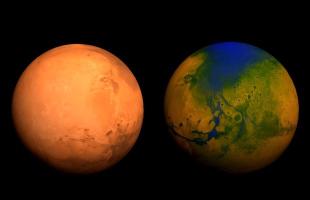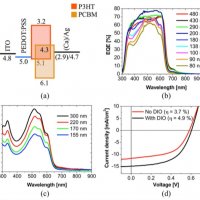Copy Link
Add to Bookmark
Report
The Martian Chronicle No 03

****************************************************************************
T h e M a r t i a n C h r o n i c l e
July 1990 No. 3
****************************************************************************
The electronic newsletter by the International Mars Patrol (IMP), an
observing program of the Association of Lunar and Planetary Observers (ALPO)
Edited by: J.D. Beish
----------------------------------------------------------------------------
THE 1988 APPARITION OF MARS
By the end of June 1989, the ALPO Mars Section had received more than
1,000 letters and cards from interested amateur and professional astronomers
located in 42 foreign countries and U.S. territories: Arabia, Argentina,
Austria, Australia, Belgium, Bolivia, Brasil, Canada, Mainland China, Repub
lic of China, Czechoslovakia, Columbia, England, Faroe Islands, France,
Germany, Greece, India, Israel, Italy, Japan, Korea, Mexico, New Guinea,
New Zealand, Norway, Nova Scotia, Okinawa, Philippines, Polynesia, Puerto
Rico, Romaina, Rwanda, Scotland, South Africa, Somoa, Spain, Sweden, St.
Croix, Taiwan, the USA, and Venezuela.
The massive response to the most favorable Mars apparition in over a
century is largely the result of the late Charles F. Capen's efforts in
establishing the IMP. Because the IMP network was already intact, there was
unprecedented international cooperation. Additional tactical support was
provided by the Oriental Astronomical Association (OAA), the British Astro
nomical Association (BAA),the Arbeitskreis Planetenbachter (Germany) and the
Groupement International d'Observateurs des Surfaces Planetaires (GIOSP).
A total of 411 telescopes were used by IMP Mars observers this appari-
tion averaging 11.8 inches in aperture. Although most of the telescopes used
by observers ranged between 3 to 16 inches in aperture, several astronomers
employed reflectors of 20, 42, 60, and 90 inches and refractors of 6, 23,
24, and 33 inches.
By Jun 12, 1989, 304 observers from 22 countries had contributed 7,063
quality Mars observations (4,818 drawings, 2,038 photographs, 16 CCD images,
and 191 micrometer measurements), an indication of increasing interest in
scientific study of the Red Planet. Included in the voluminous collection of
observations were several VCR tapes with hours of images of Mars. A very
successful observing program indeed!
THE 1900 APPARITION OF MARS
The ALPO Mars Recorders wish to thank those who participated and to
extend our welcome to any one wishing to contribute observations during the
1990 apparition. The ALPO Mars Section comprises of five Mars Recorders that
have been assigned specific geographic locations and/or areas of interest.
Those who are interested in participating in the International Mars Patrol
and wish to receive the more advanced IMP newsletter, the Martian Chronicle,
send 8 Self Addressed Stamped Envelopes (SASE) to the following ALPO Mars
Recorder that reseides in your location:
J.D. Beish, 9460 Toni Drive, Miami, Florida 33157 -- Alabama, Arkansas,
Florida, Georgia, Hawaii, Kentucky, Mississippi, North Carolina, South
Carolina, Tennessee, and Virginia.
Harry Cralle, 3902 E. 29th Street (J-4), Bryan, Texas 77802 -- Arizona,
California, Colorado, Kansas, Louisiana, Missouri, Nevada, New Mexico,
Oklahoma, Texas, Utah, and Wyoming.
Carlos Hernandez, 2714 Plaza Drive, Woodbridge, New Jersey 07095
-- Alaska, Connecticut, D.C., Delaware, Massachusetts, Maryland, Maine, New
Hampshire, New York, New Jersey, Pennsylvanian, Road Island, and Vermont.
Don C. Parker, Coral Gables, Florida 33156 -- Overseas and U.S. Terri-
tories.
Dan Troiani, 629 Verona Ct., Schaumburg, Illinois 60193 -- Idaho,
Illinois, Indiana, Iowa, Michigan, Minnesota, Montana, Nebraska, North
Dakota, Ohio, Oregon, South Dakota, Washington, West Virginia, and Wiscon
sin.
Those wishing to join ALPO please write to: Harry D. Jamieson, ALPO
Membership Sectretary, P.O. Box 143, Heber Springs, Arkansas 72543.
----------------------------------------------------------------------------
DUST STORMS ON MARS
What Mars may lack in white clouds and hazes during its southern spring
and summer is more than made up for by one of the most spectacular phenomena
seen in nature -- the great Martian dust storms. The current apparition
(1990) is termed "perihelic" because Mars will be close to the Sun (and
therefore the Earth) when it is at opposition. At perihelion, which occurred
on June 29 of this year, Mars is some 43 million kilometers closer to the
Sun than at aphelion. Current theory holds that the resultant 40% increase
in solar radiation provides enough thermal energy to raise dust and hold it
aloft for prolonged periods. Thus when Mars is near perihelion as it is now,
we frequently see dust clouds form which often spread with tremendous veloc-
ities to cover large portions of the planet. Occasionally one of these
storms will have enough energy to cover the entire planet and is termed a
"global" dust storm. Such massive obscurations occurred in 1956, 1971, 1973,
and 1977 (two storms).
While numerous dust clouds have been seen on Mars in the northern
spring and summer, extensive and long-lasting dust storms are extremely rare
for these seasons. Transient or short lived and small dust storms have been
reported in past but they were observed to last only a few days and did not
expand or move about very much.
Much has been written about the characteristics of these dust clouds
and how to detect them. These dust clouds are very difficult to identify in
their beginning stages and, in some cases, go undetected even after they
have fully developed. On the other hand, some observers have confused bright
Martian desert regions or bright fog areas with dust clouds. Others see the
bright orographic clouds in Tharsis as dust clouds. While many observers
accept that the yellow-white appearance of some clouds indicates the
presence of dust particles, they should not classify all bright clouds that
appear to be yellowish as "dust clouds."
THE COLOR OF MARTIAN DUST CLOUDS
In the past, astronomers have identified Martian dust clouds and/or
obscurations as "yellow clouds." Confusion over the colors of Mars is
nothing new. Observers often report several of Mars' darker albedo features,
or "maria," to appear quite green or even blue at times. This has led scien-
tists of the past to speculate that vegetation grew on Mars during its
springs and early summers. When we observe bright Mars against the dark
nighttime sky, the planet's color hues are often perceived as complementary
to the dark background sky. This effect is known as "simultaneous contrast"
[See Sky & Telescope, May 1989, p.474, "What's New on Mars?" by William K.
Hartmann].
If we consider that Mars only varies from a dark gray-orange/brown to a
slightly brighter grayish-orange or grayish-brown, it becomes interesting
when attempting to describe the color of Martian dust clouds as "yellow."
While dust clouds may appear yellowish when observed without the aid of
color filters, they are in fact brighter in red and orange light than they
are in yellow light. Thus it may be necessary to reclassify these clouds as
simply "dust clouds."
Martian dust clouds usually form rapidly when finely divided surface
materials are raised by the Martian wind. These clouds may be small, local-
ized, and short lived, or they may expand to cover most or all of the planet
in a matter of days. Dust clouds brighten faintly in yellow filters and
reveal sharpened boundaries through orange and red filters. During the
initial stages of formation, they often appear very bright in violet and
ultraviolet light (photographic), suggesting the presence of ice crystals.
Thus dust clouds are frequently confused with bright white areas, frosts, or
high localized clouds on Mars. Because these dust clouds are often confused
with bright surface deposits it becomes more difficult to determine the
extent of the dust cloud expansion once the observer identifies it as dust
on the move. Fresh surface deposits of dust tend to brighten the area where
its has fallen and appears to colease with the dust cloud on the move.
In recent years, the popular media has played up the romance of Martian
dust storms to such an extent that virtually any form of meteorological
activity has been reported as dust. Therefore, in analyzing your observa-
tions, the ALPO Mars Recorders have had to exercise considerable caution in
defining dust clouds. We have applied the following criteria:
1. The sine qua non of Martian dust clouds is movement with obscuration
of previously well-defined albedo features. Absence of this criterion in the
present study disqualified a candidate from inclusion under dust clouds.
2. They are bright in red light.
3. When these clouds reach heights of several kilometers, we have
proposed that they may cast shadows -- that are observable from Earth.
There are numerous reports of anomalous transient dark surface markings
appearing near dust clouds, especially when the solar phase angle was rea-
sonably large.
THE NOT-SO-RED PLANET
Further evidence for a dusty Martian atmosphere is not nearly so sophis-
ticated as that obtained by professional instrumentation. In fact, it comes
from "the man on the street!" In 1988, we received numerous phone calls and
letters from nonastronomers as well as from experienced observers stating
that Mars is not red this year, but rather orange, even when it is near the
horizon. During the 1988 apparition, however, Mars' contrast was subdued
more than "usual" and visual and photographic colorimetry do indeed reveal
frequently greenish hues. Perhaps the most compelling evidence for the
presence of persistent dust in Mars' atmosphere comes from observations the
most prominent feature on the planet -- the South Polar Cap.
ALPO GUIDELINES FOR MARTIAN DUST CLOUDS/STORMS
New guidelines have been established by the ALPO Mars Recorders for
interpreting Martian dust clouds/storms, they are as follows:
I. Type of Observation.
1. White cloud or bright area mistaken for dust cloud.
2. Visual observation(s) of dust cloud or storm.
3. Instrumental observation(s) of dust cloud/storm (Includes
photographic, polarimetric, spacecraft data, or other data by
instrumental means).
II. Classifications of Martian dust clouds.
1. Obscuration - Not sure if surface or atmospheric.
2. Dust Haze - Partial obscuration with displacement.
3. Bright dust cloud - Bright obscuration with displacement.
4. Limb projection/terminator protrusion by dust cloud.
III. Classifications of a Martian dust storm.
1. Local: Dust storm with major axis not to exceed 2000 km.
2. Regional: Dust storm with major axis that exceeds 2000 km in
either or both hemispheres of Mars.
3. Planet Encircling: Dust storm with major axis that completely
encircles either one or both hemispheres of Mars.
---------------------------------------------------------------------------
OBSERVING AIDS
The physical and geocentric positions of Mars is available in the "A.L.P.O.
Solar System Ephemeris," send $6.00 (for those living in the U.S, Canada,
and Mexico; $8.50 (for those in other countries) to: John E. Westfall,
A.L.P.O. Director/Editor, P.O. Box 16131, San Francisco, CA 94116.
"Introduction to Observing and Photographing the Solar System," by Thomas A.
Dobbins, Donald C. Parker, and Charles F. Capen. Available from Willmann
Bell, Inc., P.O. Box 35025, Richmond, VA 23235
Also, see the latest news on Mars in the August 1990 issue of Sky&Telescope
**********************************NOTICE***********************************
The Mars Observer's Handbook is out of print and no longer available.
ct brighter in red and orange light than they
are in yellow light. Thus it may be necessary to reclassify these clouds as

















